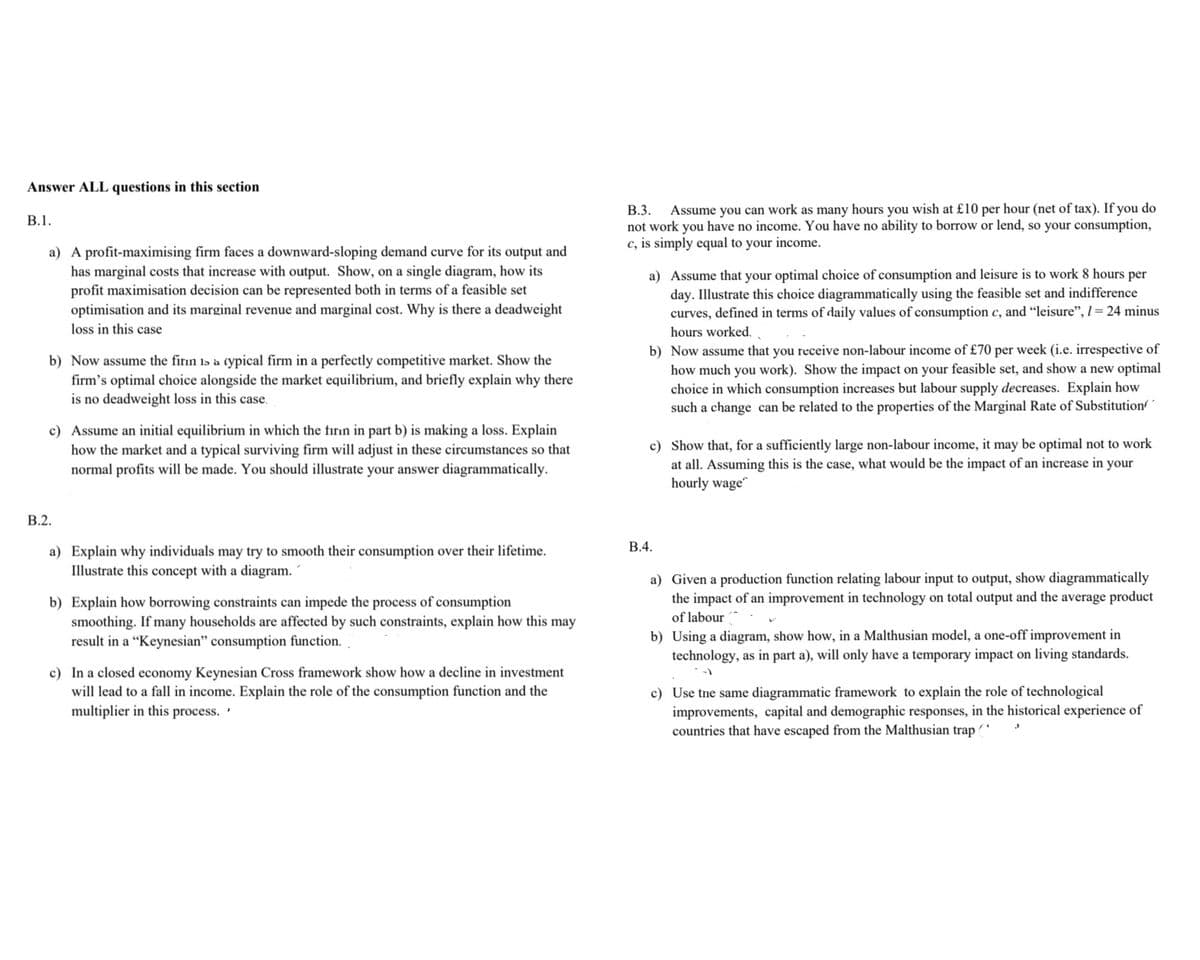B.4. a) Given a production function relating labour input to output, show diagrammatically the impact of an improvement in technology on total output and the average product of labour b) Using a diagram, show how, in a Malthusian model, a one-off improvement in technology, as in part a), will only have a temporary impact on living standards. c) Use tne same diagrammatic framework to explain the role of technological improvements, capital and demographic responses, in the historical experience of countries that have escaped from the Malthusian trap
B.4. a) Given a production function relating labour input to output, show diagrammatically the impact of an improvement in technology on total output and the average product of labour b) Using a diagram, show how, in a Malthusian model, a one-off improvement in technology, as in part a), will only have a temporary impact on living standards. c) Use tne same diagrammatic framework to explain the role of technological improvements, capital and demographic responses, in the historical experience of countries that have escaped from the Malthusian trap
Chapter1: Making Economics Decisions
Section: Chapter Questions
Problem 1QTC
Related questions
Question
100%
Hi,
I need help with B.4.
Thank you

Transcribed Image Text:Answer ALL questions in this section
Assume you can work as many hours you wish at £10 per hour (net of tax). If you do
not work you have no income. You have no ability to borrow or lend, so your consumption,
c, is simply equal to your income.
В.3.
В.1.
a) A profit-maximising firm faces a downward-sloping demand curve for its output and
has marginal costs that increase with output. Show, on a single diagram, how its
profit maximisation decision can be represented both in terms of a feasible set
optimisation and its marginal revenue and marginal cost. Why is there a deadweight
a) Assume that your optimal choice of consumption and leisure is to work 8 hours per
day. Illustrate this choice diagrammatically using the feasible set and indifference
curves, defined in terms of daily values of consumption c, and "leisure", l= 24 minus
loss in this case
hours worked.
b) Now assume the firın Is à cypical firm in a perfectly competitive market. Show the
firm's optimal choice alongside the market equilibrium, and briefly explain why there
is no deadweight loss in this case.
b) Now assume that you receive non-labour income of £70 per week (i.e. irrespective of
how much you work). Show the impact on your feasible set, and show a new optimal
choice in which consumption increases but labour supply decreases. Explain how
such a change can be related to the properties of the Marginal Rate of Substitution/´
c) Assume an initial equilibrium in which the firın in part b) is making a loss. Explain
how the market and a typical surviving firm will adjust in these circumstances so that
normal profits will be made. You should illustrate your answer diagrammatically.
c) Show that, for a sufficiently large non-labour income, it may be optimal not to work
at all. Assuming this is the case, what would be the impact of an increase in your
hourly wage
В.2.
В.4.
a) Explain why individuals may try to smooth their consumption over their lifetime.
Illustrate this concept with a diagram.
a) Given a production function relating labour input to output, show diagrammatically
the impact of an improvement in technology on total output and the average product
b) Explain how borrowing constraints can impede the process of consumption
smoothing. If many households are affected by such constraints, explain how this may
result in a “Keynesian" consumption function.
of labour
b) Using a diagram, show how, in a Malthusian model, a one-off improvement in
technology, as in part a), will only have a temporary impact on living standards.
c) In a closed economy Keynesian Cross framework show how a decline in investment
will lead to a fall in income. Explain the role of the consumption function and the
multiplier in this process.
c) Use tne same diagrammatic framework to explain the role of technological
improvements, capital and demographic responses, in the historical experience of
countries that have escaped from the Malthusian trap ( ^
Expert Solution
This question has been solved!
Explore an expertly crafted, step-by-step solution for a thorough understanding of key concepts.
Step by step
Solved in 2 steps with 2 images

Knowledge Booster
Learn more about
Need a deep-dive on the concept behind this application? Look no further. Learn more about this topic, economics and related others by exploring similar questions and additional content below.Recommended textbooks for you


Principles of Economics (12th Edition)
Economics
ISBN:
9780134078779
Author:
Karl E. Case, Ray C. Fair, Sharon E. Oster
Publisher:
PEARSON

Engineering Economy (17th Edition)
Economics
ISBN:
9780134870069
Author:
William G. Sullivan, Elin M. Wicks, C. Patrick Koelling
Publisher:
PEARSON


Principles of Economics (12th Edition)
Economics
ISBN:
9780134078779
Author:
Karl E. Case, Ray C. Fair, Sharon E. Oster
Publisher:
PEARSON

Engineering Economy (17th Edition)
Economics
ISBN:
9780134870069
Author:
William G. Sullivan, Elin M. Wicks, C. Patrick Koelling
Publisher:
PEARSON

Principles of Economics (MindTap Course List)
Economics
ISBN:
9781305585126
Author:
N. Gregory Mankiw
Publisher:
Cengage Learning

Managerial Economics: A Problem Solving Approach
Economics
ISBN:
9781337106665
Author:
Luke M. Froeb, Brian T. McCann, Michael R. Ward, Mike Shor
Publisher:
Cengage Learning

Managerial Economics & Business Strategy (Mcgraw-…
Economics
ISBN:
9781259290619
Author:
Michael Baye, Jeff Prince
Publisher:
McGraw-Hill Education